Brief

Executive Summary
- Many banks have committed to reaching net-zero carbon emissions spanning their own operations and the financed emissions of their retail and commercial customers.
- Banks face three main challenges: getting an accurate baseline of emissions in their lending and other financed portfolios, understanding whether and where value will emerge during the climate transition, and relearning the discipline of long-horizon strategy.
- Banks that start their transition earlier and double down on the effort, our analysis finds, stand to reap significant profit growth by realizing better economics in their portfolios than banks that hesitate to act.
There is a growing recognition that banks have a pivotal role to play in financing the global transition away from carbon-emitting activities. They’re under pressure from stakeholders to reduce the financed emissions footprint of their loan portfolios. Many have committed to reaching net-zero financed emissions by 2050, with interim results in 2030.
Much of the latest scientific modeling suggests that carbon emissions need to reach net zero by the middle of the century to afford a reasonable chance of limiting warming to 1.5 degrees Celsius. Achieving net-zero emissions means that some greenhouse gases are still released but are offset by removing an equivalent amount of gases from the atmosphere.
Financed emissions represent at least 95% of banks’ overall carbon footprint, dwarfing the effect of emissions from their own operations. To deliver on their commitment, then, banks will have to actively engage with and support their customers’ own decarbonization efforts.
This climate transition will prove an enormous challenge for some industries in banks’ portfolios. For instance, about 90% of oil and gas companies and about 35% of electric utilities are tracking toward more than 2.7 degrees of warming. Without active steering of their portfolios, banks face a tougher road than anticipated to meet their targets and will track above 2 degrees.
To help achieve net-zero carbon emissions, a sector-wide coalition called the Glasgow Financial Alliance for Net Zero (GFANZ) was launched in April 2021 and currently includes more than 450 financial institutions, of which 110 are banks—60 based in Europe, 18 in Asia-Pacific, 17 in North America, and 15 in South America and Africa.
When Bain & Company examined the top 15 banks by assets in three regions—Europe, Asia-Pacific, and North America—65% of them had pledged to reach net-zero financed emissions by 2050. All of the top 15 banks in Europe have committed to decreasing carbon emissions, spurred by the EU and UK regulatory institutions, which have led in promoting the climate transition. In North America, 11 of the top 15 have committed, and three of the top 15 in Asia-Pacific.
Of these 45 banks, almost half have disclosed their current financed emissions, though only partially, with a focus on carbon-intense industries such as coal, oil and gas, and electric power (see Figure 1). ING, for instance, is measuring emissions intensity for seven industries and absolute emissions on 90% of its portfolio. And ABN AMRO has disclosed absolute emissions on 65% of its portfolio.
About half of big banks disclose current financed emissions and interim targets, but only on part of their portfolio

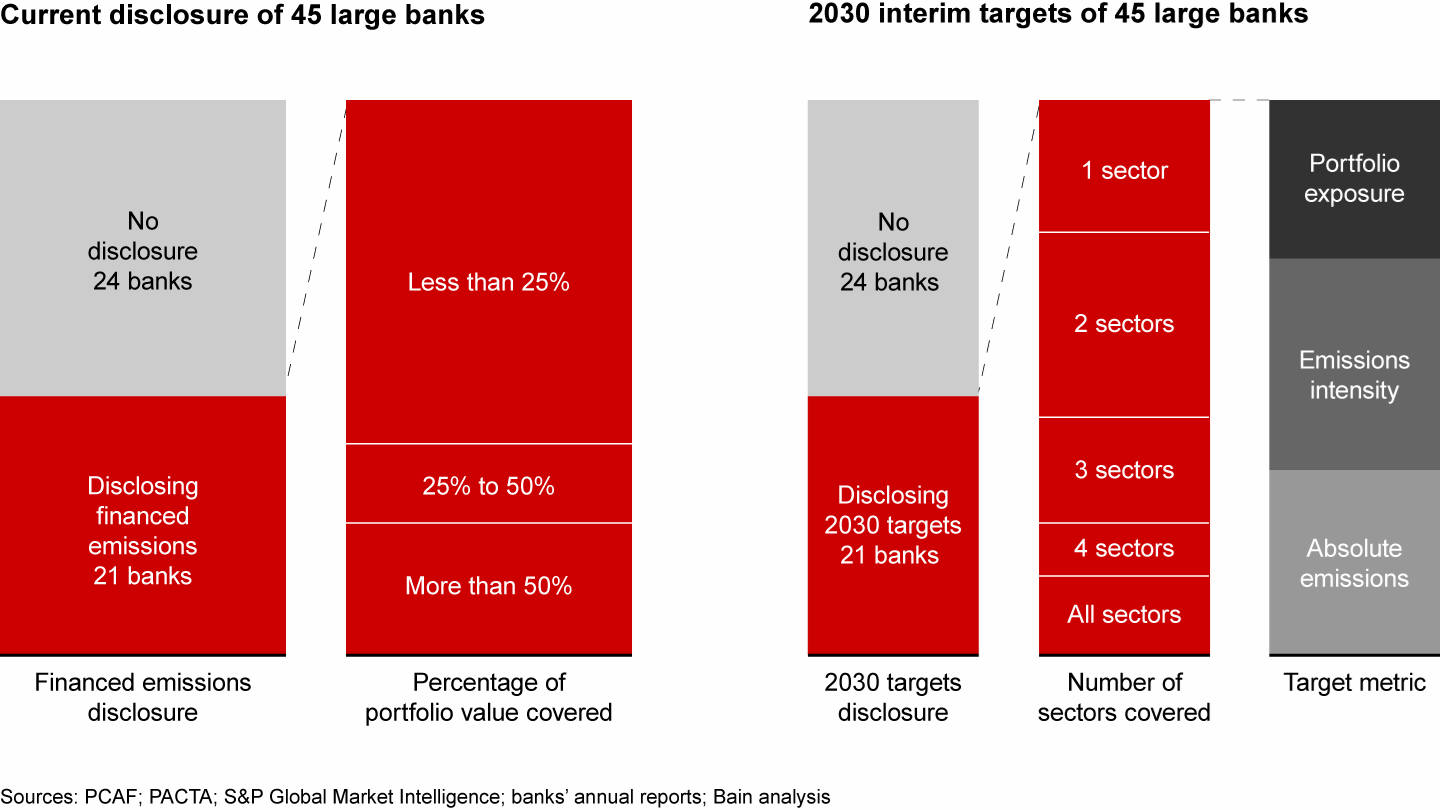
Some 45% of the banks have publicly shared 2030 interim targets, though only for selected sectors. For example, BNP Paribas has pledged to cut emissions intensity in three priority sectors by 2025—10% in oil and gas, 25% in automotive, and 30% in electric power—in line with the International Energy Agency’s net-zero scenario.
The wide variance in the number and industries covered across banks, as well as the methodologies and key metrics they use, makes it difficult to accurately compare their disclosures of emissions baselines and interim targets.
With banks still at the early stages of the transition, new Bain analysis shows where the most severe challenges lie:
- Measurement of carbon emissions turns out to be quite complicated and varies substantially depending on the granularity and detail of the available data.
- Banks are unsure whether they can create value during the transition to net zero, and if they can, how they will do so.
- The sector currently tends to focus on quarter-to-quarter objectives with a three-year strategic plan, at most, but the climate transition will require a much longer strategy horizon, akin to an electric utility.
Let’s review each challenge in turn, and how banks can overcome them.
The tricky task of measuring carbon emissions
Measuring emissions, an essential first step in the climate transition, proves more complicated than some bank leaders thought. Banks will need to use the emissions data of the clients and projects in their portfolios. The more granular the data, the more accurately it can be measured.
One of the prominent measurement standards, put forward by the Partnership for Carbon Accounting Financials (PCAF), defines a data quality score incorporating the granularity and specificity of emissions data. The score ranges from 1 for highly certain data to 5 for highly uncertain (nonspecific and general) data.
To understand whether data granularity has a big effect on the reliability of measurements, we calculated the carbon footprint for four representative loan portfolios: electric power, metallurgy, automotive, and home mortgage. We chose three methodologies in line with the PCAF standard:
- a high-level approach, using an industry average or other nonspecific data, suitable for the lowest data quality;
- an intermediate approach for average data quality; and
- a granular approach for higher data quality.
Our analysis shows that the carbon footprint for similar representative portfolios can vary by more than twofold in either direction, depending on the granularity of data available and the associated measurement methodology (see Figure 2).
A bank portfolio’s carbon footprint can vary a lot with the granularity of the data and the associated measurement method

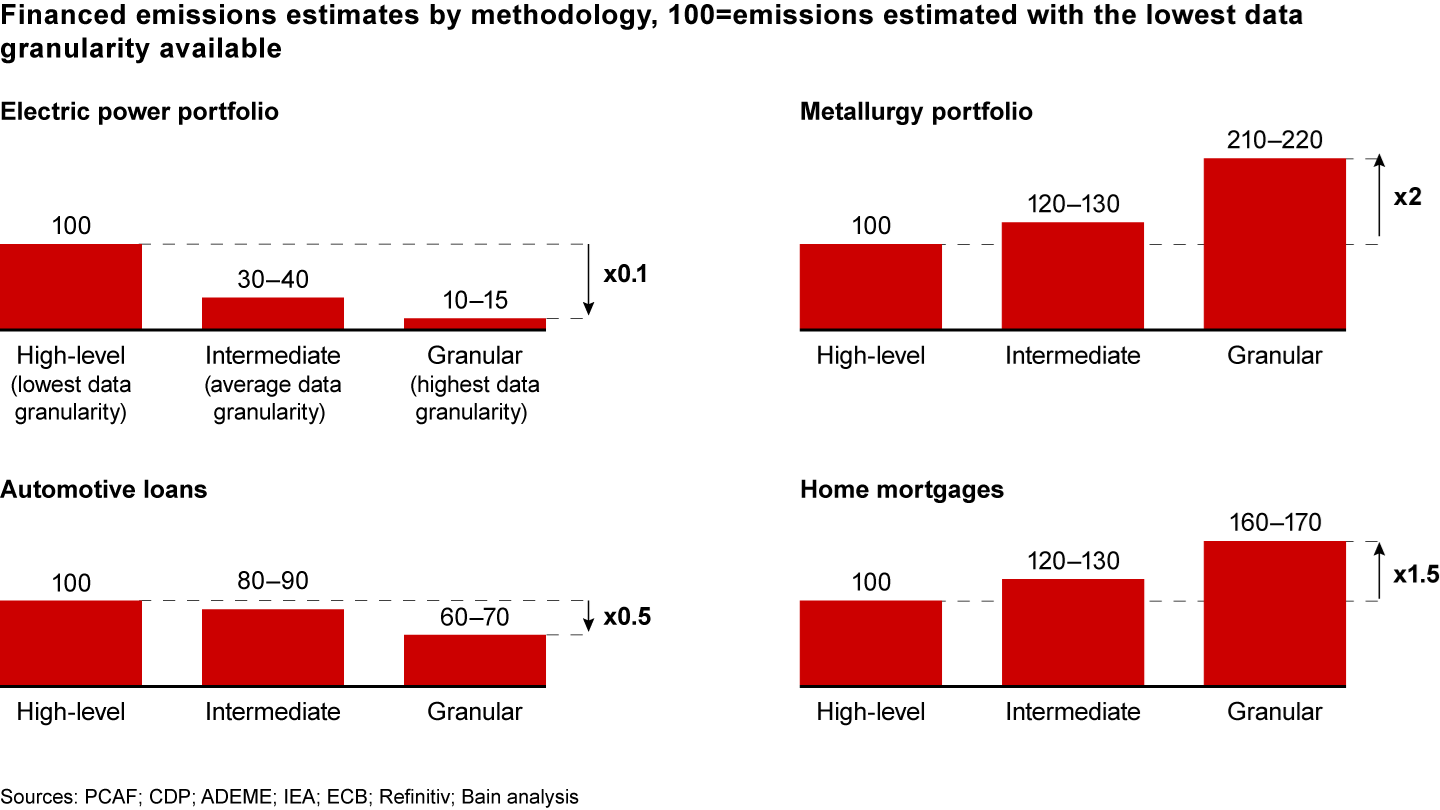
Most banks currently rely on emissions data with little granularity for large shares of their portfolios, which allows them to make only intermediate or high-level measurements. Few banks have a view into the carbon footprint of funded clients and projects at the most specific level—the activity, location, energy sources, or other characteristics that may correlate with emissions. Based on data disclosed by five major banks in each of two industries, the average score ranges between 3 and 4.3, with 5 being the poorest quality score (see Figure 3).
Banks currently have low-quality emissions data

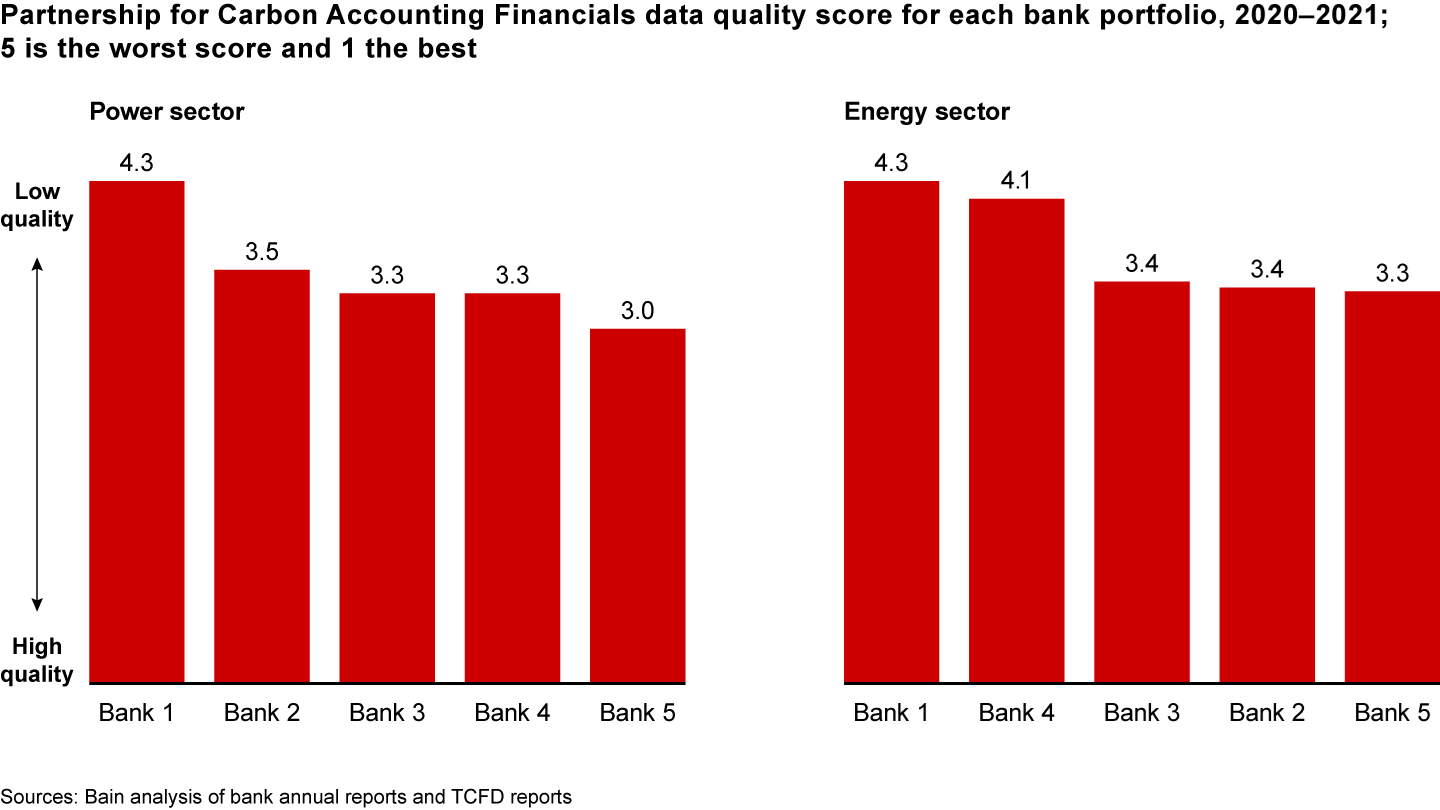
Bridging the gap between even an average score and a higher one will take a major effort, but it’s well worth it. Low data granularity heightens the risk of sharply under- or over-estimating the emissions baseline and thus setting the wrong targets. Banks need to invest in the processes, tools, data, and partnerships that will allow them to improve their data granularity and accurately track their financed emissions.
Creating value through the climate transition
Beyond regulatory mandates, banks are wrestling with the challenge of creating value from the transition to net-zero financed emissions. They’re asking these questions: What specifically will drive value throughout the transition? What is the effect on value creation of different transition strategies? How quickly will value accrue over the next 30 years?
To understand how the climate transition will affect value creation for a bank over time, we undertook a detailed analysis of loan portfolio strategies. Our model focuses on how a portfolio’s value will evolve over the next 30 years based on its climate transition strategy—in particular, whether the strategy is proactive or reactive. We did not assess the evolution of the overall banking profit pool, and we assumed that macroeconomic factors such as growth of the banking sector, inflation, or changes in various interest rates and capital charges will affect banks equally, independent of their choice of strategy.
We defined a value formula that incorporates both volume and profitability. Factors that influence volume include the following:
- Incremental financing. GFANZ estimates that roughly $2 trillion to $5 trillion of incremental annual funding will be required through 2040 to support a successful transition, through such projects as renewable energy replacing coal-fired plants. Banks are expected to finance part of these efforts, as are corporations, households, and public and private funding.
- The mix of green and traditional assets. As the climate transition unfolds, banks will increase the share of green assets in their portfolio as existing clients reduce their carbon footprint and new investments are made.
- Divestment of traditional assets. Divestment will likely proceed slowly over the next two decades, given banks’ focus on supporting clients in their transition. It will then pick up steam from 2040 to 2050 as regulation tightens further and traditional assets become less attractive.
Factors that influence profitability include the following:
- Cost of risk. Evidence is mounting that green assets currently benefit from a lower cost of risk. As the share of green assets rises, we assume the gap in cost of impairment between green and traditional assets will widen over the long run for corporate loans as traditional business decreases. This gap will shrink for consumer loans as green auto loans and mortgages progressively expand to more risky segments.
- Cost of funding. Banks’ credit ratings will continue to determine the cost of funds, and we expect that the carbon profile will increasingly affect those ratings.
For our calculations, we modeled a bank with a representative portfolio in terms of geographic footprint, industry exposure, and product mix. Based on the volume and profitability factors, we simulated how this model bank’s profits would change between 2021 and 2050, excluding inflation or market growth, under three different choices around the climate transition:
- Pioneer. The bank displays an early, strong commitment to climate transition. This assumes high-caliber emissions tracking to inform strategic decisions and actively support clients with funding, advice, and relevant products. It also assumes active loan portfolio steering based on both profit and carbon footprint.
- Follower. The bank undertakes the climate transition, but not quickly or aggressively. This takes shape as support for a few high-emissions customers and an opportunistic, conservative approach to green financing.
- Laggard. The bank delays and adopts a passive approach with limited climate-related actions, mainly tied to regulatory requirements.
A pioneer bank will benefit the most
Each approach has a different outcome on profits, with the pioneer bank outperforming because of a more rapid and robust transition. All else equal, a pioneer will grow profits by 25%–30% by 2050, compared to 5%–10% for a follower, and a profit erosion of -10% to -20% for a laggard (see Figure 4).
A pioneer bank will create far more value than a follower or laggard

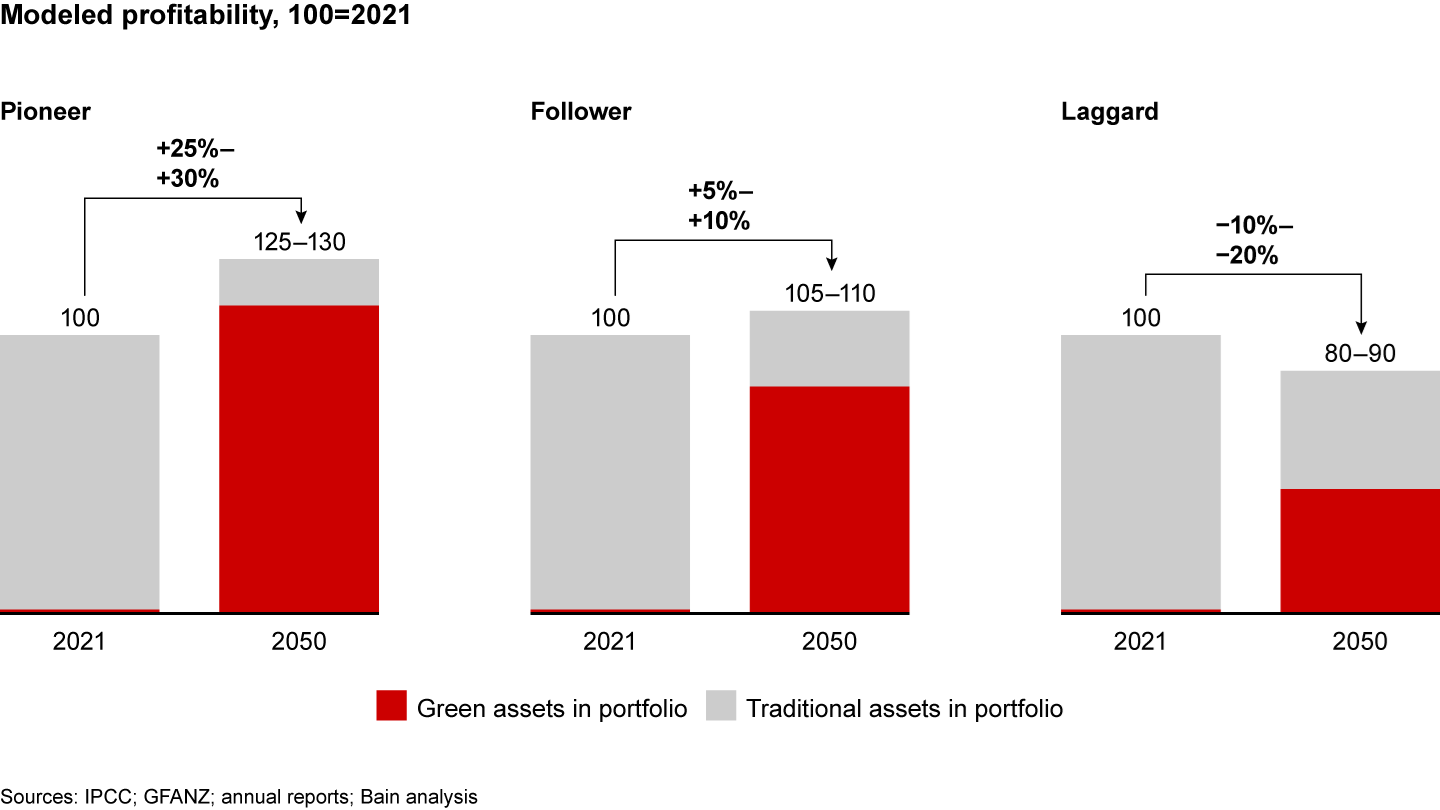
What accounts for the pioneer’s superior performance is the combination of a greener, larger portfolio and more competitive economics. A pioneer will be able to capture a greater share of the incremental financing required for the climate transition, especially in the early years.
The pioneer will also shift a larger share of its portfolio to green assets—about 85% of the portfolio, on average, by 2050—as it actively engages current clients and infuses carbon criteria in targeting new projects or clients. By contrast, a laggard will shift only 40%–50% of its portfolio. At the same time, a pioneer will have a limited need to divest traditional assets over the 30 years, with only 3%–5% required divestment, versus fully 10%–15% for a laggard (see Figure 5). The laggard has less flexibility to transition high-risk industries or projects early—for instance, stranded assets in coal or steel production caught by tighter regulations and eroding economics.
A pioneer bank will shift more and faster to green assets in its corporate loan portfolio

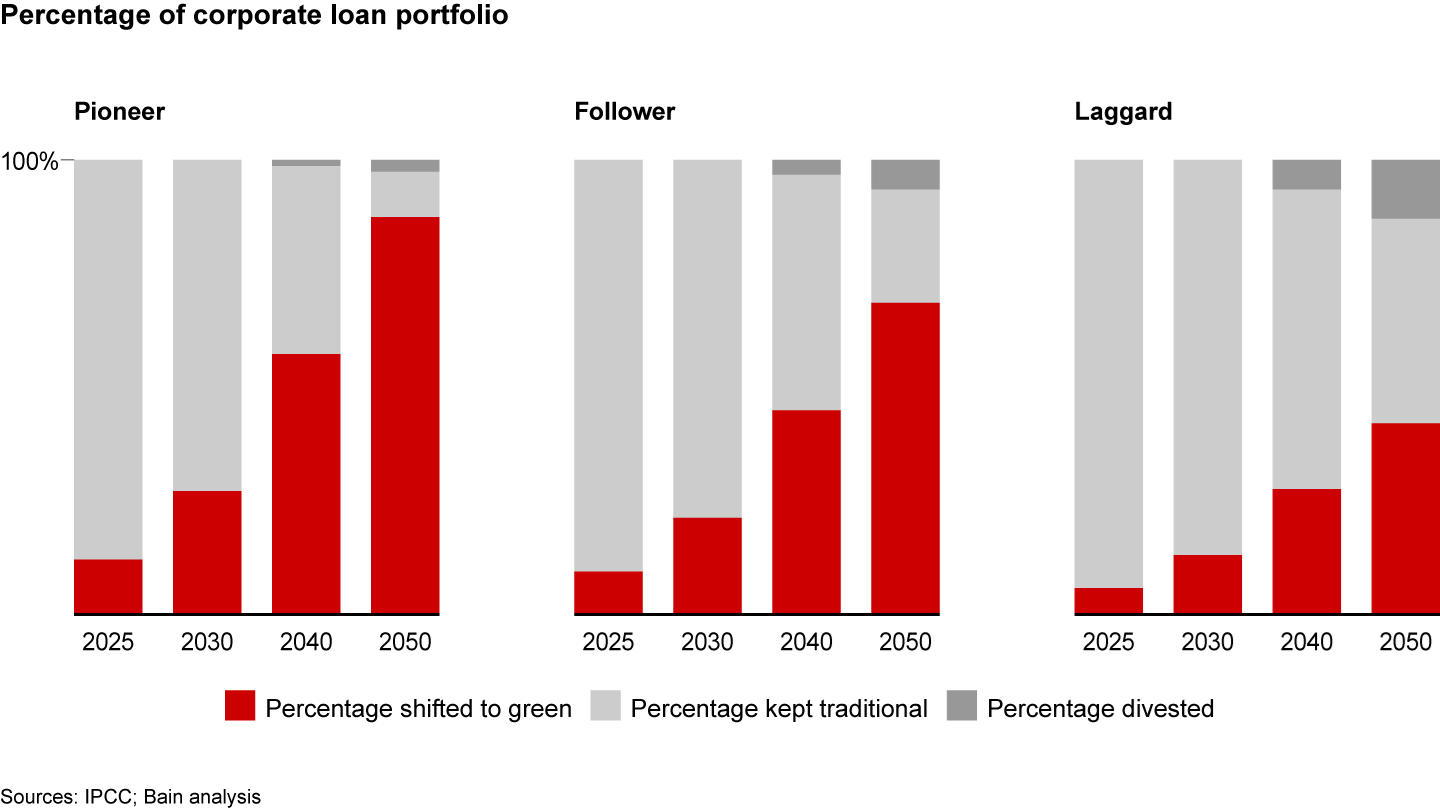
In addition, the economics become more favorable for pioneers, through a higher interest rate, net of the cost of funding, and the cost of risk due to greater exposure to green assets.
The benefits will take some time
The benefits for a pioneer bank will be more limited until around 2025, but its early investment will allow it to build a competitive advantage over the long run. Here’s how this dynamic plays out (see Figure 6):
- Until 2025, all strategies cluster together in terms of profit, given the progressive ramp-up of green loans and bonds as well as stable economics for the traditional assets portfolio.
- From 2025 to 2030, the pioneer bank reaps benefits, while the follower and laggard remain relatively stable.
- From 2030 to 2040, new value accelerates for the pioneer, while the follower and the laggard start to diverge.
- From 2040 to 2050, the pioneer clearly advances over the rest of the pack. The follower starts catching up as it reaps rewards from improving its portfolio mix, while the laggard is increasingly penalized for its high exposure to traditional industries and projects.
A pioneer bank will start to reap outsize profitability after 2025

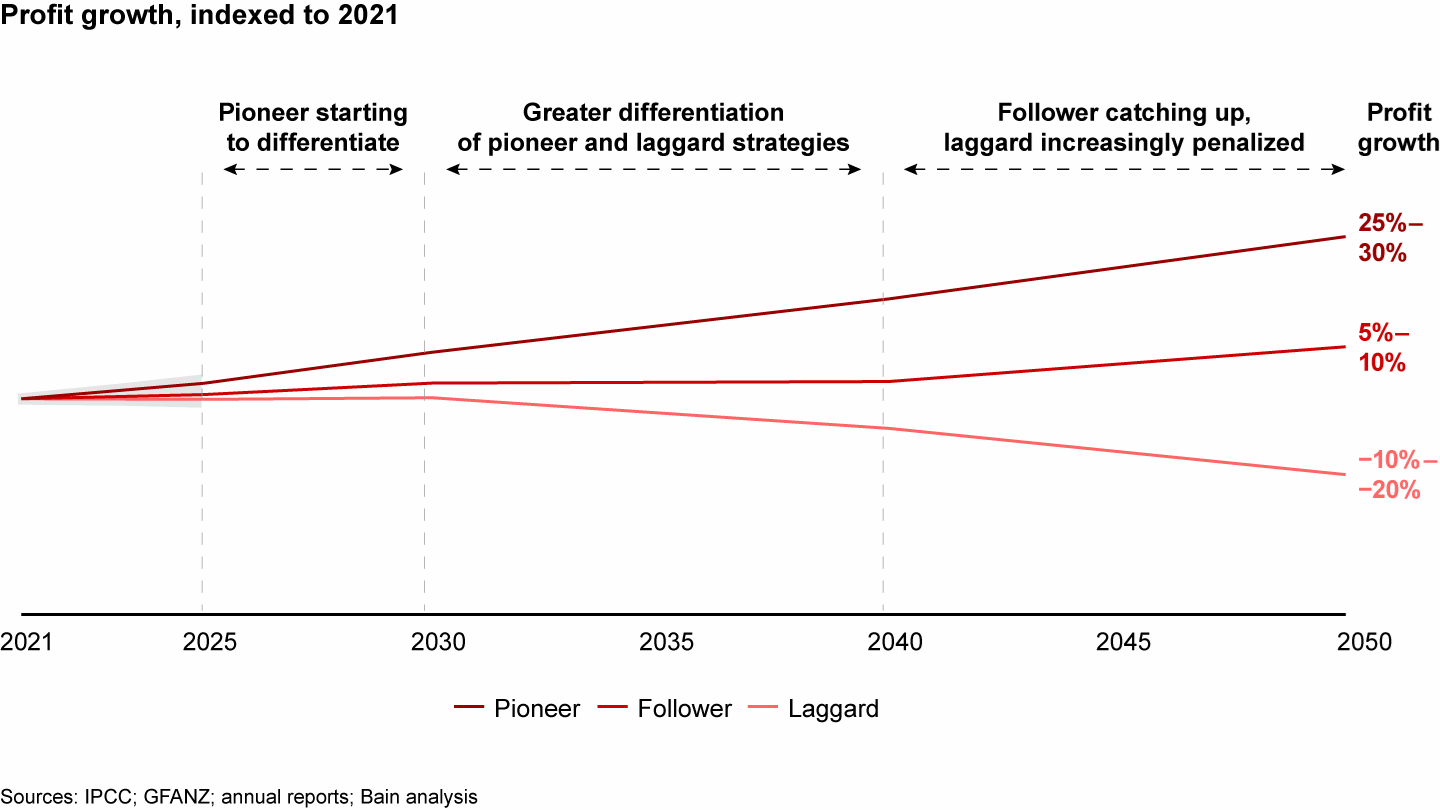
We expect banking regulators and governments to progressively align on transition requirements. Until that happens, each bank must decide on its appetite for taking a pioneer approach. The choice of strategy for a bank and the pace of benefits realization might vary across regions depending on the maturity of the transition locally.
Adaptable strategy for a long horizon
The transition to net-zero carbon emissions will involve many uncertainties over a long period, especially in the realms of regulation and technology. For example, the timing of peak demand for fossil fuels is still uncertain, yet has consequences for the attractiveness of future investments, the risk of stranded energy assets, and the conditions of financing. And in many countries, the pace and extent of regulation around green standards for new and renovated housing will affect development of the green mortgage market.
A successful climate transition thus requires banks to adopt a long-term strategy with short- and medium-term actions anchored in a horizon of at least five to ten years, more akin to an electric utility. That’s a change from the current mismatch between banks’ typical strategic planning horizon of two to three years and the much longer climate transition.
Think of this long-term effort like crossing a fast-flowing river dotted with stones that’s so wide the other side is barely visible. With each step to a stone, you can see the next few stones and choose the one that looks the most stable in the swirling water. Stone by stone, the riverbank becomes visible and the way clearer. Each stone represents a short-term “today-forward” step, while the distant riverbank stands for the long-term “future-back” goal.
Successful strategy will entail a solid understanding of transition scenarios, their implications for the speed and shape of the transition, and how the transition might change over time. And to effectively navigate the many uncertainties, it will also rely on quantitative and qualitative signposts such as changes in regulation, technological breakthroughs, and the performance of market participants.
Longer horizons don’t mean slower decision making. As the carbon transition proceeds, banks that are able to adapt quickly and decisively will thrive. Nimble decision making relies on a menu of potential actions that give banks greater flexibility. These include no-regrets moves (such as setting up emissions tracking, green bonds, and other climate-related capabilities), hedges, and smaller investments that can be ramped up quickly (investment in nascent green technologies). It also includes big bets on which scenario is most likely and will require a major commitment but could yield a major payoff (such as a large investment in green hydrogen).
Bringing the strategy to life
To bring this long-horizon, adaptable strategy to life, we return to the importance of strong measurement. Capabilities to support effective measurement and tracking of carbon emissions in the portfolio will consist of reliable methodologies, standards, and tools.
Banks will also need to set up methods for steering the portfolio in a way that constantly calibrates for both emissions and profitability. Investment renewals, new investments, and divestments should all link consistently with the chosen transition strategy.
Perhaps the most important component of effective execution consists of strong governance that furthers the climate transition. The executive overseeing the climate transition must have sufficient authority and positioning to succeed. Dedicated time to discuss the transition with the executive committee and board, incentives that favor emissions progress, and shareholder communications that convey the value derived from the transition will all help keep the enterprise on track (see Figure 7).
Bringing an adaptable, long-horizon strategy to life

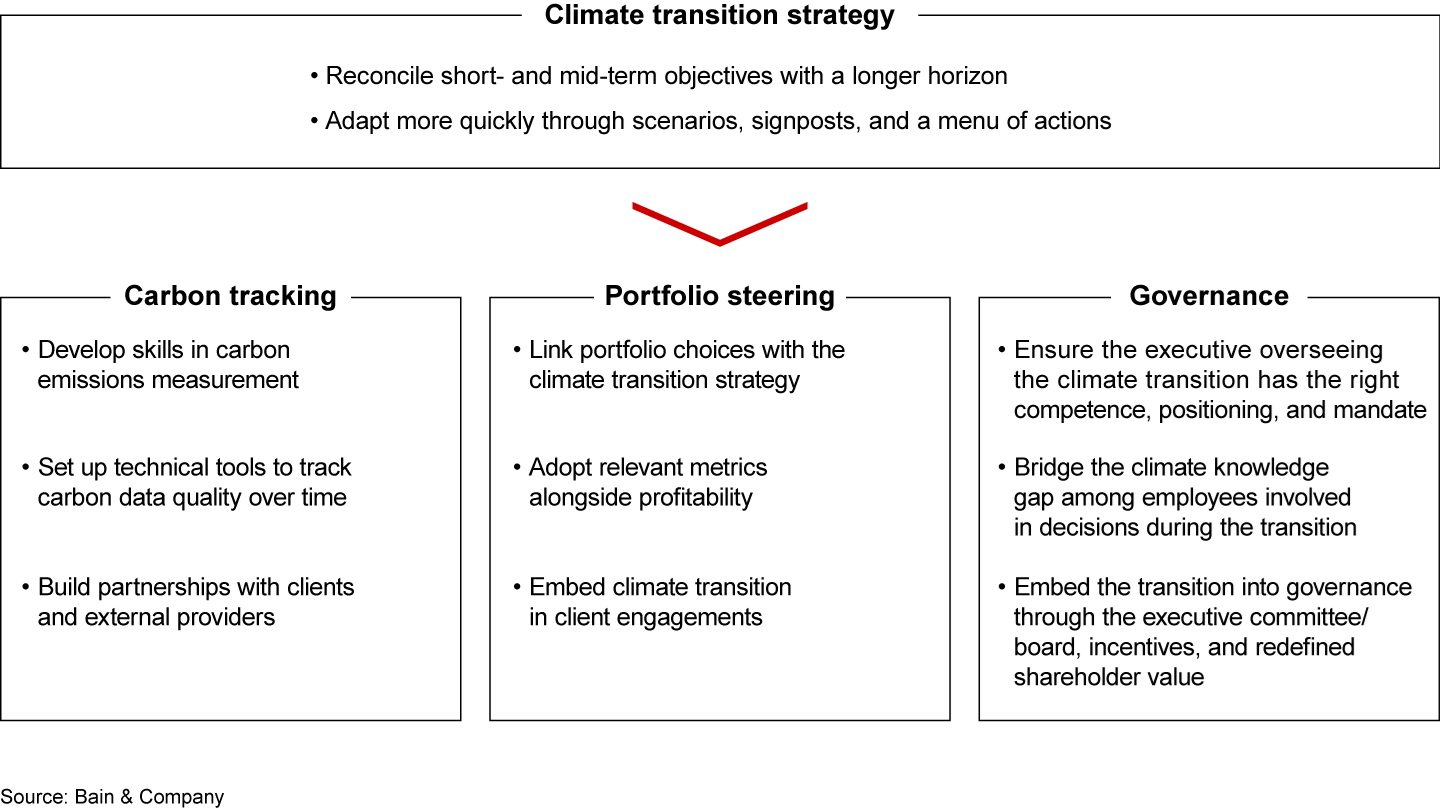
This climate transition will affect all aspects of the bank—internal strategy and execution; external relationships with regulators, clients, and shareholders; and potentially, the bank’s competitive standing in the market. Since it’s easier to set a goal than attain it, the hard work now begins. Banks that embrace the challenge very soon stand to emerge as more profitable, credible leaders in a greener economy.